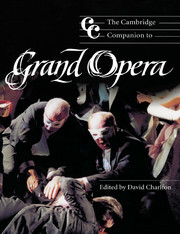Book contents
- Frontmatter
- 1 Introduction
- Part I The resourcing of grand opera
- Part II Revaluation and the twenty-first century
- Part III Grand operas for Paris
- Part IV Transformations of grand opera
- 16 Richard Wagner and the legacy of French grand opera
- 17 Grand opera in Russia: fragments of an unwritten history
- 18 Grand opera among the Czechs
- 19 Italian opera
- 20 Grand opera in Britain and the Americas
- Notes
- Select bibliography
- Index
18 - Grand opera among the Czechs
from Part IV - Transformations of grand opera
Published online by Cambridge University Press: 28 November 2011
- Frontmatter
- 1 Introduction
- Part I The resourcing of grand opera
- Part II Revaluation and the twenty-first century
- Part III Grand operas for Paris
- Part IV Transformations of grand opera
- 16 Richard Wagner and the legacy of French grand opera
- 17 Grand opera in Russia: fragments of an unwritten history
- 18 Grand opera among the Czechs
- 19 Italian opera
- 20 Grand opera in Britain and the Americas
- Notes
- Select bibliography
- Index
Summary
On 28 March 1884 Fibich's The Bride of Messina (Nevěsta Messinská – designated a ‘tragic opera’, but a music drama in all but name) was premièred in the nearly new Czech National Theatre, recently risen phoenix-like from the devastating fire of 1881 that had closed it only days after its long-awaited opening (see Fig. 28 opposite). Two days later there was a performance of Dvořák's four-act, grand opera Dimitrij, which had been premièred two years before in the latter days of the old Provisional Theatre. The Bride of Messina limped on for five performances in 1884 and a further two in 1885 to dwindling houses; by contrast, Dvořák's Dimitrij, which had run for fifteen performances in 1882 and 1883, was given twenty times in its revised version over a two-year period and by the end of the century was one of the most frequently performed of all non-comic Czech operas. The fact that Dimitrij filled the theatre while The Bride of Messina gradually emptied it tells us much about contemporary taste. Few if any Czech operas from the national revival (dating, loosely speaking, from the opening of the Prague Provisional Theatre on 18 November 1862) were more ideologically conceived than Fibich's Bride. The libretto was by Otakar Hostinský, one of Prague's foremost musical theoreticians and academics, a fine amateur artist, a man of letters and a well-known writer on aesthetics; the music was by the most evidently intellectual Czech composer of the day, the husband of one of the National Theatre company's most respected singers, Betty Fibichová, and the darling of Prague's Czech-speaking chattering classes.
- Type
- Chapter
- Information
- The Cambridge Companion to Grand Opera , pp. 366 - 382Publisher: Cambridge University PressPrint publication year: 2003
- 1
- Cited by

